The beautifully landscaped city of Suzhou is located in the
south-east of Jiangsu Province. The Grand Canal (Sui Dynasty
581-618), which flows from Beijing to Hangzhou (the capital of
Zhejiang Province) has irrigated Suzhou aiding its illustrious
culture and turning it into prosperous land. It is of little
surprise that Suzhou is called ''Heaven on Earth''.
Built in 541BC by He Lv, the King of Wu, 2500 year old, Suzhou is
the birthplace of Wu culture. The 8,483km2 city is bustling with
historical remnants and culture, thus placing Suzhou third behind
Beijing and Xi'an for its historical and cultural significance. It
has been named as one of China's top 24 historical and cultural
cities and is only one of the four tourist cities with
environmental protection (the other three being Beijing, Hangzhou
and Guilin). In 1997, Suzhou caught the world's attention by having
its classic gardens placed on the UNESCO list as a World Cultural
Heritage site.
Suzhou is a key silk production centre in China and the embroidery
school here is ranked in the "top 4" for the whole of China.
The attractiveness of Suzhou is also evident in its performing arts
(folk songs of Wu), Kunqu Opera and storytelling, as well as stele
carving, calligraphy and painting.
Dating back to more than 2,500 years, Suzhou is one of China's
oldest cities. After the completion of the Beijing-Hangzhou Grand
Canal the city began to thrive during the Sui Dynasty.












